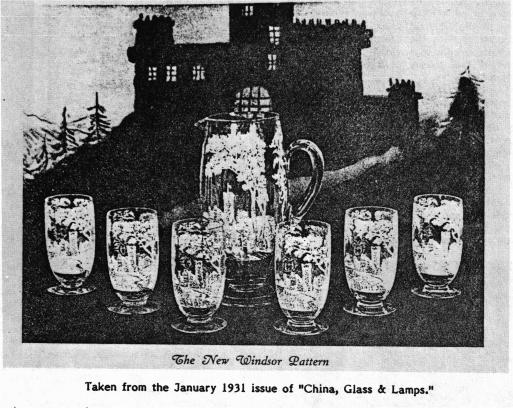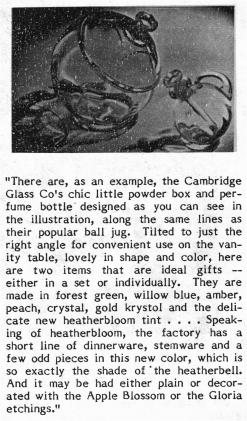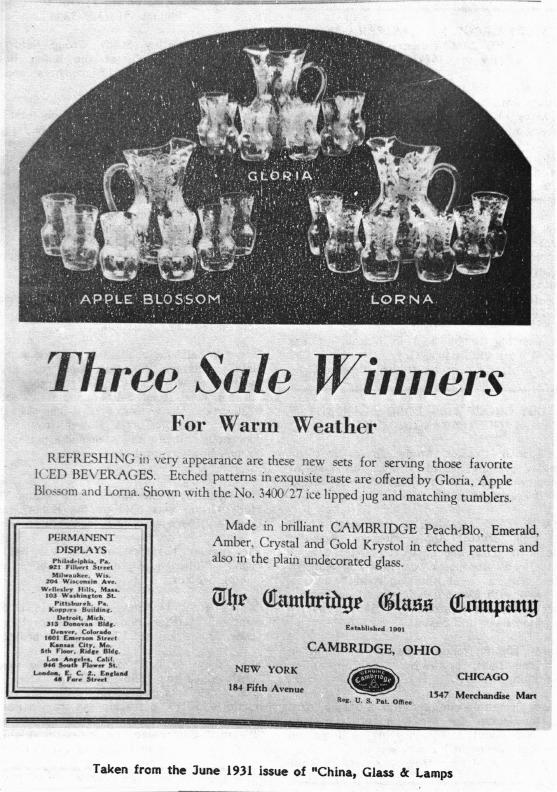Transparent Colors, Part VI
by Mark A. Nye
Issue No. 193 - May 1989
The text of the 1931 China, Glass and Lamps, Trade Directory entry for Cambridge read as follows:
"COLORED AND CRYSTAL GLASSWARE Lines complete in Stemware, Dinnerware, Centerpieces, Vases and Novelties. A wide selection of Blown and Pressed Glassware of high quality and outstanding design in Etchings, Gold and Silver Encrustations, Rock Crystal and Plain Ware. In Cambridge Colors: Gold Krystol, Emerald, Willow-Blue, Peach-Blo, Amber-Glo, Ebony, Carmen, Royal Blue, Crystal."
Annually, for many years, Cambridge issued a daily diary, and in the front of each, was a brief synopsis of what the factory was expected to be doing during the year. From the 1931 diary comes this:
"Lines complete in Etchings, Engravings, Gold Encrustrations and Plain Ware in Cambridge colors: Gold Krystol, Emerald, Peach-Blo, Amber-Glo, Willow-Blue, Ritz Blue, Ebony."
Since the China, Glass & Lamps Trade Directory, in all probability, would have gone to press after the Cambridge diary, it no doubt is a more accurate reflection of the colors being produced or planned for at the Cambridge factory, as 1931 opened.
In a full-page advertisement published in the January 1931
issue of China, Glass & Lamps, Cambridge issued an
 invitation for buyers to attend the Pittsburgh Exhibit, and introduced
their newest etching, Windsor.
invitation for buyers to attend the Pittsburgh Exhibit, and introduced
their newest etching, Windsor.
"Among many new things in CAMBRIDGE wares for 1931 is the beautiful etching which we have named "Windsor." The etching art reaches a high place in this new pattern. It is offered in Crystal only. Other new creations include shapes and decorations in Gold Krystol, Peach-Blo, Emerald, Amber and Willow Blue."
After this was published, Cambridge did go on to produce the Windsor etching in color.
A report on the Cambridge exhibit at the Pittsburgh Show appeared in the February issue of China, Glass & Lamps, and read in part:
"New Colors for Cambridge - As its new colors in glassware, the Cambridge Glass Co. offered "Carmen," a bright ruby and "Burgundy," a deep amethyst. In its "Gold Krystol" color, which is a golden yellow, Cambridge had a new stemware shape and added square cups and saucers to its dinnerware line in this color. A pleasing combination in dinnerware and stemware was "Gold Krystol" and amber. A flower block in "Gold Krystol" is the only one made in the topaz or golden yellow color range ... "
Whether or not Cambridge officially ever used the name "Burgundy" is open to conjecture. If they did, it was for a very short period at the time of its introduction, for no known Cambridge advertisement, catalog or price list uses the name. Instead, it is "amethyst" that appears as the name for the purple color produced at the Cambridge plant.
Cambridge carmen is described in the book Colors in Cambridge Glass, as a rich full bodied red ... "Although there is some range in the density of the color, carmen does not bear the depth of color or hardness of appearance that is often found in the ruby colors of other glass companies."
From the same book comes this description of amethyst. "This very rich color, although quite deep in tone, is typical of the softness of appearance that exemplifies the darker colors of Cambridge"
In March 1931, a full-page advertisement in China, Glass & Lamps introduced the Lorna etching, with the following text:
"The beauty of the brilliant Decagon line is now enhanced by the introduction of this new etching. The LORNA is truly a brilliantly attractive etching. It should be immensely popular. Available in complete lines, including Stemware, Dinnerware, Individual Decorative Pieces and Novelty Items. Made in the CAMBRIDGE colors: Gold Krystol, Amber, Emerald, Peach-Blo and Crystal."
Cambridge hopes for Lorna did not materialize, or it would appear that way, since very little of the pattern is seen today, in color or crystal.
The first mention of carmen in an advertisement came in March 1931, when the Victorian or Martha Washington #1269 candelabra was illustrated with this text:
"It is their Victorian Candelabra. The ten prisms and bobache are Krystol and the piece stands 11 inches high. The body of the candelabra is an old reproduction line of the punty type. It comes in Gold Krystol, carmen (ruby) and Krystol."
Note the spelling and terminology in the preceding. We normally see bobache spelled bobeche, and Krystol in all probability referred to colorless glass and not to the frosted colorless glass. The term "old reproduction line" might be better stated as reproduction of an old line."
Another advertisement, from around the same time, featured the Luster Cut Prism Candlesticks, #1270, #1271, #1272 and #1273, and stated they were being made in crystal, gold krystol, carmen, ebony, amber, emerald and peach, all with crystal bobeche and prisms.
In June 1931 this report was printed in China, Glass & Lamps:
"In line with this trend, the Cambridge Glass Co.'s dinnerware and stemware in ruby color - which they call "Carmen" - is among their best sellers. It has been used effectively in many table settings in the stores, either in its entirety or just the stemware, combined with appropriately decorated china and since ruby dinnerware is so strikingly different, it has attracted a great deal of favorable attention.
This same company is making short dinnerware lines as well
as stemware in two rich colors - royal blue and amethyst and, of course, there are pieces of flatware in each of these three colors. The jug in the illustration is in peach and is decorated with the Gloria etching, but is equally lovely in royal blue and crystal, one of the several colors in which is produced ... "
Thus we have the first mention of yet another Cambridge color, royal blue. Royal Blue has been described as "a deep color of transparent blue with a pleasant softness that will show highlights trending toward the reds." It is the blue often referred to by many non-Cambridge collectors as "cobalt blue."
In September 1931, yet another color was introduced, and it was forest green. The following photo (right) and quotation is taken from that month's issue of China, Glass & Lamps. >
"Above is some Cambridge glass dinnerware, their No. 3400 line, combined with which is the No. 3035 stemware shape. Both feature the Gloria pattern. While crystal is shown in the illustration, this may be had in the full range of Cambridge colors, outstanding among which is their brand new Forest Green. This is being shown at their display room, 184 Fifth Avenue."
Colors in Cambridge Glass describes forest green as a
"soft, cool, dark shade of transparent green that tends toward yellow."
It is much darker than light emerald, and will not be confused with it.
However, the late emerald, from 1949, is a very similar color and
collectors often confuse the two. The best way to distinguish these
 colors is by the piece, as few items produced in forest green were ever
made in late emerald.
colors is by the piece, as few items produced in forest green were ever
made in late emerald.
This photo (right) and the following quotation are taken from the November 1931 issue of China, Glass & Lamps.
"There are, as an example, the Cambridge Glass Co.'s chic little powder box and perfume bottle designed as you can see in the illustration, along the same lines as their popular ball jug. Tilted to just the right angle for convenient use on the vanity table, lovely in shape and color, here are two items that are ideal gifts - either in a set or individually. They are made in forest green, willow blue, amber, peach, crystal, gold krystol and the delicate new heatherbloom tint ... . Speaking of heatherbloom, the factory has a short line of dinnerware, stemware and a few odd pieces in this new color, which is so exactly the shade of the heatherbell. And it may be had either plain or decorated with the Apple Blossom or the Gloria etchings."
And thus we have yet another new color being produced at the Cambridge plant. Heatherbloom can be a deceiving color. When it is viewed with natural light (daylight) or incandescent lighting, heatherbloom appears as a very delicate pale orchid or lavender. Lighted by a fluorescent source, it becomes light blue or even gray in appearance. Similar changeable colors were also produced by Fostoria, Heisey and Tiffin.
December 1931 saw the #3122 stemware available in forest green, royal blue, amber, carmen, gold krystol, peach, emerald, heatherbloom and crystal. This same month saw the #3400 Ball shape line being promoted as new for 1932 and coming in the colors of crystal, amber, peach, forest green, emerald, royal blue, amethyst, ebony, gold krystol, heatherbloom and willow blue.
To be continued ...

